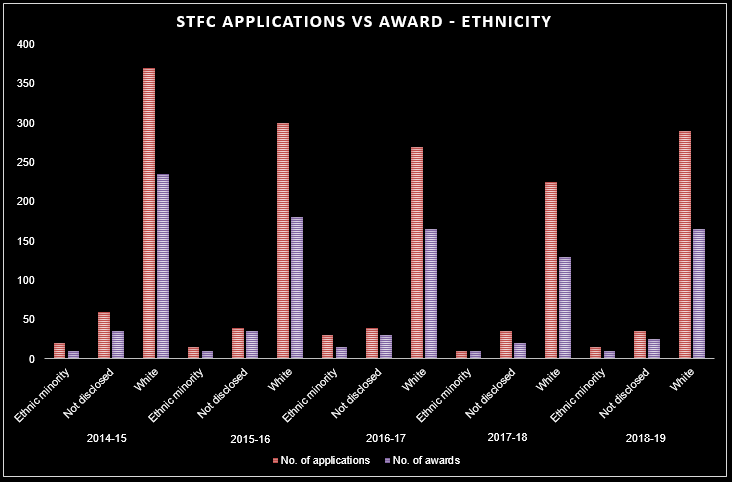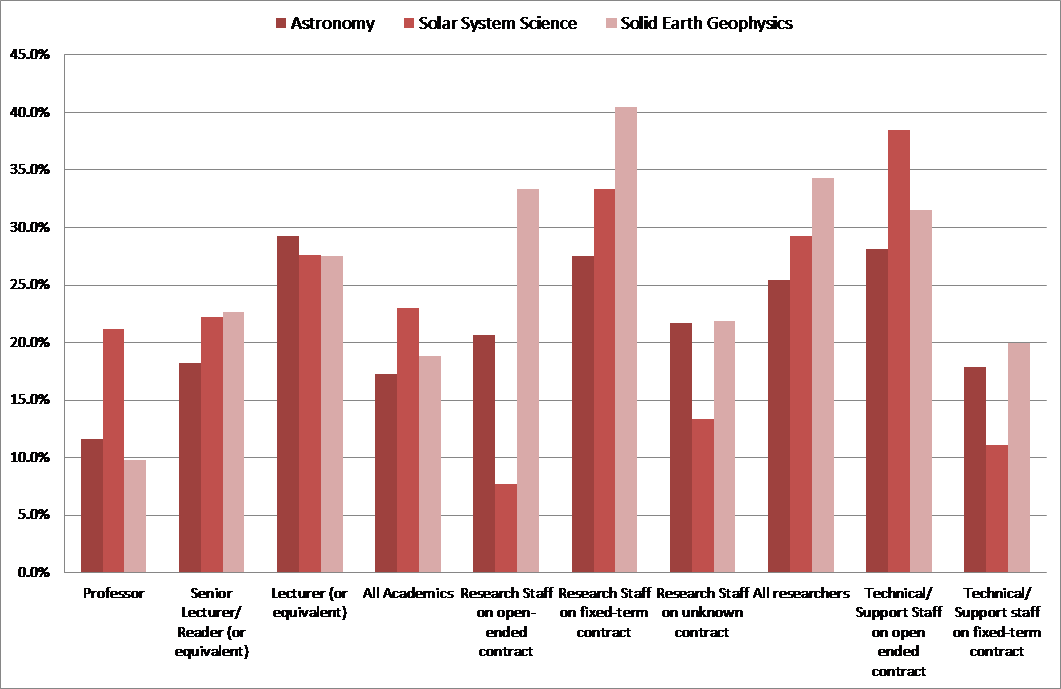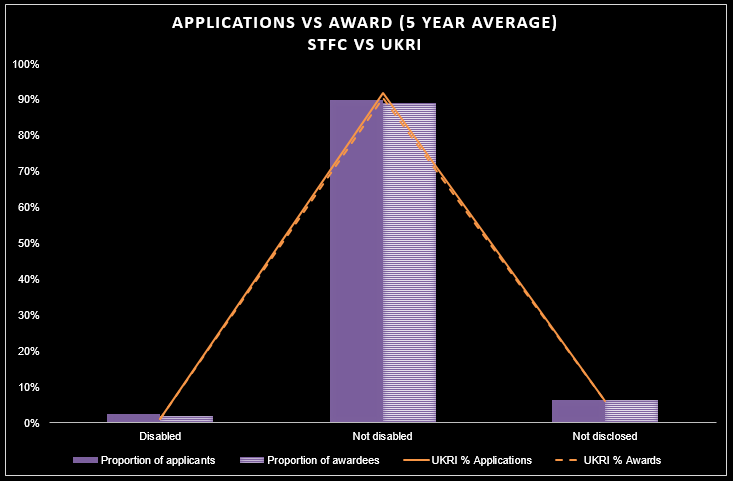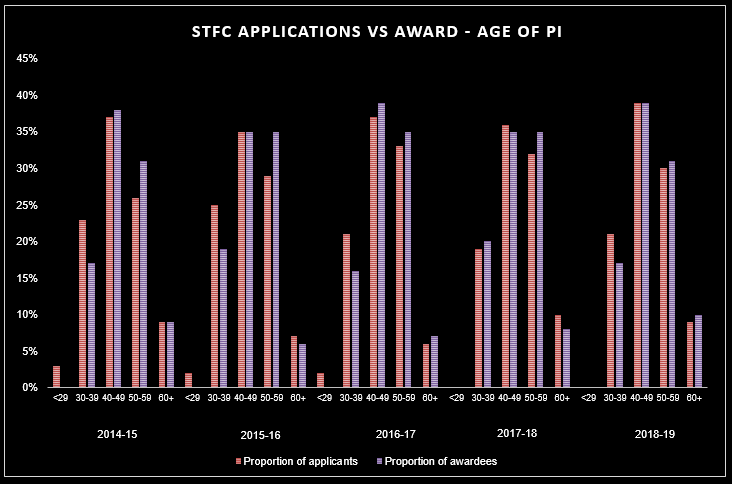
Who wants to see the #Diversity data for @STFC_Matters, that was released by @UKRI_News last week?
The full data release is here, so if you want to see anything for yourself, go ahead: ukri.org/about-us/equal…
The full data release is here, so if you want to see anything for yourself, go ahead: ukri.org/about-us/equal…
https://twitter.com/UKRI_News/status/1275737934465908736
@STFC_Matters funds research & training into astronomy, particle physics, space & planetary sciences & nuclear physics. This is important because @ukhesa only report STFC as #physics – it’s so much more!
STFC have a #equality & #diversity statement here: stfc.ukri.org/funding/promot…
STFC have a #equality & #diversity statement here: stfc.ukri.org/funding/promot…
So, let’s start with @STFC_Matters #ethnicity data.
Worth noting that @UKRI_News collate three categories; ethnic minority, white, not disclosed.
We can’t separate out different ethnicity, which is a problem in itself.
Worth noting that @UKRI_News collate three categories; ethnic minority, white, not disclosed.
We can’t separate out different ethnicity, which is a problem in itself.

Here is the data over the last 5 years; % of PI applications vs awards made.
Whilst fewer minority researchers are now applying for funding than previously (why?), @STFC_Matters are increasing the % awards made to ethnic minority PIs.
Whilst fewer minority researchers are now applying for funding than previously (why?), @STFC_Matters are increasing the % awards made to ethnic minority PIs.

How does this compare to the @UKRI_News average, across all research councils?
@STFC_Matters are below the UKRI average for awards made to ethnic minority researchers, but are above average for undisclosed ethnicity on applications.
Why?
@STFC_Matters are below the UKRI average for awards made to ethnic minority researchers, but are above average for undisclosed ethnicity on applications.
Why?

Let’s look at the @ukhesa return for @STFC_Matters researchers - can this be explained?
It reveals that there are more ethnic minority researchers in the field than in these UKRI data. But, it’s possible it’s not being reported correctly – look at the % of undisclosed ethnicity
It reveals that there are more ethnic minority researchers in the field than in these UKRI data. But, it’s possible it’s not being reported correctly – look at the % of undisclosed ethnicity

How about the £ value of those awards to PIs?
Is there a discrepancy between white researchers and those from ethnic minorities?
Yes, but not what we might expect.
Is there a discrepancy between white researchers and those from ethnic minorities?
Yes, but not what we might expect.
There is no trend in £ value to PIs in @STFC_Matters funding over the 5 year period.
In some years, researchers from ethnic minorities were awarded more £ than white researchers. Some years, it was less.
In some years, researchers from ethnic minorities were awarded more £ than white researchers. Some years, it was less.

Let’s dig deeper.
Looking at application value vs award value, we see a trend.
The data reveal that ethnic minority researchers were more likely to get the full value requested (80-100%) compared to white researchers (59-67%) in the same period.
2018-19 was different
Looking at application value vs award value, we see a trend.
The data reveal that ethnic minority researchers were more likely to get the full value requested (80-100%) compared to white researchers (59-67%) in the same period.
2018-19 was different

But, white researchers are typically applying for more £ than their minority counterparts in the first place. Why?
This changed in 2018-19, which is also when we saw the success rate of obtaining the full value of a grant application drop below 80% for minority researchers.
This changed in 2018-19, which is also when we saw the success rate of obtaining the full value of a grant application drop below 80% for minority researchers.

So, you might be more likely to be funded if you ask for less £ in the first place, but, should you?
Is this true for all researchers, regardless of ethnicity?
Shortly, we’ll look at how this is reflected in the #gender data for @STFC_Matters.
Is this true for all researchers, regardless of ethnicity?
Shortly, we’ll look at how this is reflected in the #gender data for @STFC_Matters.
We’re back – this time tackling #gender #diversity in @STFC_Matters funding, courtesy of the recent UKRI data release.
Again, you can dive into the data yourself here: ukri.org/about-us/equal…
Again, you can dive into the data yourself here: ukri.org/about-us/equal…
Firstly, let’s state, the data are limited; we have 'male', 'female', and 'not disclosed'. That’s it.
Whilst this allows self-identity, it falls short of recognising that #gender is complex – we can do better @UKRI_News!
Whilst this allows self-identity, it falls short of recognising that #gender is complex – we can do better @UKRI_News!

Using the data we have, it is no surprise that research within the @STFC_Matters remit is male-dominated.
Several organisations are highlighting this inequity, and striving to address it, i.e. @RoyalAstroSoc & @IOPDiversity.
Several organisations are highlighting this inequity, and striving to address it, i.e. @RoyalAstroSoc & @IOPDiversity.

Some more successfully than others – just look to the recent @PhysicsNews awards list to see how far we still have to go.
This prompted action from several members of the community, including fellow 🐯s @i_jayas & @jesswade
This prompted action from several members of the community, including fellow 🐯s @i_jayas & @jesswade
https://twitter.com/i_jayas/status/1276537854408232963
Typically, only ~20% of @STFC_Matters awards go to female applicants at the PI level. Over the 5 year period, it is less than 20%.
This is far below the @UKRI_News average across all research councils, and the % of women in populations internationally.
This is far below the @UKRI_News average across all research councils, and the % of women in populations internationally.

But, is this a fair comparison?
Not all fields attract the same demographics despite national populations. Not all research councils have similar demographics.
This is important.
Not all fields attract the same demographics despite national populations. Not all research councils have similar demographics.
This is important.
The most recent @RoyalAstroSoc demographic survey of its fellowship, who work in #astronomy, #SolarSystem science & #physics, found that of those in permanent academic positions (eligible to be an @STFC_Matters PI), only 17-23% were female, dependent on discipline. 

This is in line with the @STFC_Matters funding rate.
But, no less disappointing.
You can see the full @RoyalAstroSoc demographics report here: ras.ac.uk/news-and-press…
But, no less disappointing.
You can see the full @RoyalAstroSoc demographics report here: ras.ac.uk/news-and-press…
Let’s look at @ukhesa data for @STFC_Matters researchers.
The % of awards made to female PIs is actually greater than proportion of female researchers reported in the HESA return.
Conversely, the % of awards made to male PIs is less than the HESA return for STFC researchers.
The % of awards made to female PIs is actually greater than proportion of female researchers reported in the HESA return.
Conversely, the % of awards made to male PIs is less than the HESA return for STFC researchers.

Remember, @ukhesa only report #Physics for @STFC_Matters, so these data aren’t entirely accurate.
Many researchers in STFC-funded fields, particularly #Space & #PlanetaryScience, may be returned to other research councils instead, most likely @NERCscience or @EPSRC.
Many researchers in STFC-funded fields, particularly #Space & #PlanetaryScience, may be returned to other research councils instead, most likely @NERCscience or @EPSRC.
So, what about the £ value of those awards? What does that look like?
Well, it’s not good.
Women receive, on average, 57% of what their male counterparts do. And that’s including a bumper year in 2017-18 where this discrepancy was lowest.
Well, it’s not good.
Women receive, on average, 57% of what their male counterparts do. And that’s including a bumper year in 2017-18 where this discrepancy was lowest.

If we look at the applications vs awards £, we see this trend – and the ‘bumper year’ in 2017-18, where women asked for more than men, for the first time.
The proportion of award vs application (%) is actually higher for women on average – 68% vs 65%.
The proportion of award vs application (%) is actually higher for women on average – 68% vs 65%.

So, women were more successful, but for every £1 we’re asking for, men ask for £1.77. Why?
@STFC_Matters are funding women in line with national subject demographics (17-23%), and with a proportional award (68%) similar to their male counterparts (65%).
@STFC_Matters are funding women in line with national subject demographics (17-23%), and with a proportional award (68%) similar to their male counterparts (65%).
So, does the issue arise before we even get to the funding application stage?
Why don’t we have more women in these fields, able to apply for these awards?
And why, alongside ethnic minorities, don’t they ask for more in the first place?
Why don’t we have more women in these fields, able to apply for these awards?
And why, alongside ethnic minorities, don’t they ask for more in the first place?
We have a systemic problem.
We need to act.
And if you thought those stats were bad, wait until you see the #disability data from @UKRI_News, coming up next.
We need to act.
And if you thought those stats were bad, wait until you see the #disability data from @UKRI_News, coming up next.
Disability is complex. There are physical & mental disabilities, plus #neurodiversity.
Not everyone with a #disability considers themselves disabled when asked.
But, data from @STFC_Matters revealed in the @UKRI_News data release are shocking!
ukri.org/about-us/equal…
Not everyone with a #disability considers themselves disabled when asked.
But, data from @STFC_Matters revealed in the @UKRI_News data release are shocking!
ukri.org/about-us/equal…
@STFC_Matters funded 5 applicants at PI level who declared a disability. 5. Over 5 years. That’s 0.005%.
In fact, it’s worse than that, because all 5 of those were funded in the same year, 2018-19.
In fact, it’s worse than that, because all 5 of those were funded in the same year, 2018-19.

STFC didn’t fund a single application from PIs with a disability between 2014 – 2018.
Not a single one.
Not a single one.
Applications from PIs with a disability were submitted in previous years, but not in 2014 or 2017.
The proportion of PIs that declared a disability is always small, ~3%. There is a more significant proportion who do not disclose whether or not they have a disability, ~7%.
The proportion of PIs that declared a disability is always small, ~3%. There is a more significant proportion who do not disclose whether or not they have a disability, ~7%.

Unfortunately, the story isn’t much better if we look at the @UKRI_News average.
In fact, over 5 years, the story doesn’t change very much. ~90% of awards are made to PIs who are not disabled, with fewer than 3% of awards going to PIs with a disability.
In fact, over 5 years, the story doesn’t change very much. ~90% of awards are made to PIs who are not disabled, with fewer than 3% of awards going to PIs with a disability.

In the most recent @RoyalAstroSoc demographics survey, 340 permanent academic staff (eligible to be a @STFC_Matters PI) responded, answering questions relating to their #gender, #ethnicity, #age, #sexuality, #carer status and #disability.
ras.ac.uk/news-and-press…
ras.ac.uk/news-and-press…
Looking at the award value of @STFC_Matters grants here is hard, as we only have one year where applications were successful, 2018-19.
However, whilst the statistical relevance is reduced, the fact that PIs with a disability receive less than PIs without a disability is clear.
However, whilst the statistical relevance is reduced, the fact that PIs with a disability receive less than PIs without a disability is clear.

What’s more, when we look at the £ awarded to PIs with a disability from @STFC_Matters against the @UKRI_News average, they fall short.
In fact, in the first year that STFC funded PIs with disabilities, the level of funding was ~50% of the UKRI average in the same period.
In fact, in the first year that STFC funded PIs with disabilities, the level of funding was ~50% of the UKRI average in the same period.

However, PIs with a disability asked for less than their non-disabled counterparts (£143k to £546k).
Why?
And are there really so few #DisabledInSTEM?
Or, are we not supporting scientists with disabilities within STEMM?
Why?
And are there really so few #DisabledInSTEM?
Or, are we not supporting scientists with disabilities within STEMM?
We’re not done.
@UKRI_News only released data in 4 categories. There are 9 ‘protected characteristics’ under UK law (Equality Act 2010): gov.uk/guidance/equal…
UKRI didn’t release data on #LGBTQ+, religion, parental status (including maternity/paternity leave) etc.
Why not?
@UKRI_News only released data in 4 categories. There are 9 ‘protected characteristics’ under UK law (Equality Act 2010): gov.uk/guidance/equal…
UKRI didn’t release data on #LGBTQ+, religion, parental status (including maternity/paternity leave) etc.
Why not?
If you’re in @STFC_Matters fields, consider looking at the @RoyalAstroSoc demographics survey: ras.ac.uk/news-and-press…
The RAS did cover each of the protected characteristics, and at various career stages too (PhD/PDRA/Fixed-term/Permanent/Technical/Academic)
The RAS did cover each of the protected characteristics, and at various career stages too (PhD/PDRA/Fixed-term/Permanent/Technical/Academic)
For now, we have 1 dataset from @UKRI_News left to investigate for @STFC_Matters, and it’s a protected characteristic not often discussed.
Age.
Note, young does not equate to #EarlyCareer. Many #ECR are not in the “young” bracket as per UKRI data collection.
Age.
Note, young does not equate to #EarlyCareer. Many #ECR are not in the “young” bracket as per UKRI data collection.
First things first, @STFC_Matters receives applications at the PI level from researchers across all age groups; <29 – 60+, and has done so every year for which we have data (2014-2019).
The data are grouped; <29, 30-39, 40-49, 50-59, 60+
The data are grouped; <29, 30-39, 40-49, 50-59, 60+
It is perhaps not surprising that the largest proportion of applications at the PI level come from the 40-49 and 50-59 age bracket. 

However, it might be more surprising that a larger proportion of 30-59 applications are funded than the % of applications.
@STFC_Matters are funding a higher % of applicants in this field than actually apply for the awards in the first place!
@STFC_Matters are funding a higher % of applicants in this field than actually apply for the awards in the first place!

So, who is being disadvantaged by this skew in award distribution?
It’s the young PIs, <29 years old.
@STFC_Matters have *never* funded a PI <29 according to the data we have.
Applications were received up to 2017, then they stopped. Maybe those rare, young PIs passed the 30 threshold, maybe they just gave up trying.
@STFC_Matters have *never* funded a PI <29 according to the data we have.
Applications were received up to 2017, then they stopped. Maybe those rare, young PIs passed the 30 threshold, maybe they just gave up trying.
As a young #ECR myself, this comes as no surprise.
Is this in line with other @UKRI_News research councils?
Unfortunately, yes.
Apparently very few young PIs exist across UKRI research councils.
@STFC_Matters fund fewer researchers <40 than the UKRI average, and more >50 than the average.
Unfortunately, yes.
Apparently very few young PIs exist across UKRI research councils.
@STFC_Matters fund fewer researchers <40 than the UKRI average, and more >50 than the average.

@EPSRC are the only ones that consistently fund young PIs each year.
Why?
Perhaps this is due to their ‘new investigator’ scheme, which encourages young (and #ECR) PIs to submit funding applications.
Are there better support schemes? Mentoring? I want to know!
Why?
Perhaps this is due to their ‘new investigator’ scheme, which encourages young (and #ECR) PIs to submit funding applications.
Are there better support schemes? Mentoring? I want to know!
So, back to @STFC_Matters, and young researchers struggling for funding.
Applications are being received. STFC receive >25% of their applications from researchers below 40. Yet, only ~17% of applications are funded.
This compares to ~67% applications from 40-59, &~70% funded
Applications are being received. STFC receive >25% of their applications from researchers below 40. Yet, only ~17% of applications are funded.
This compares to ~67% applications from 40-59, &~70% funded

Let’s look at the @ukhesa return for @STFC_Matters research. Is this what the community looks like?
No.
HESA confirms that there are more researchers in the <29 & 30-39 categories than are funded by STFC grants at PI level, and fewer 50-59 researchers.
The skew is clear.
No.
HESA confirms that there are more researchers in the <29 & 30-39 categories than are funded by STFC grants at PI level, and fewer 50-59 researchers.
The skew is clear.

Remember, these are grants at the *PI* level.
Young individuals that are able to apply for awards as a PI are *not* eligible to apply for (most) fellowships as they already have that elusive permanent position.
Young individuals that are able to apply for awards as a PI are *not* eligible to apply for (most) fellowships as they already have that elusive permanent position.
So, the cynics amongst you saying that there are other awards #ECRs should be going for, yes, perhaps.
But *young* ECRs within the @STFC_Matters remit aren’t eligible for most.
But *young* ECRs within the @STFC_Matters remit aren’t eligible for most.
Carrying on with some cynical opinions colleagues have shared with me on this, “maybe young PI’s science just isn’t good enough”.
Well, asides from being wonderfully unhelpful (thank you!), this isn’t always the case, either.
Well, asides from being wonderfully unhelpful (thank you!), this isn’t always the case, either.
Several young PIs have received proposals back from STFC with the rating “fundable, but not funded”.
So, the science *was* good enough, they just didn’t rank high enough to win funding.
So, the science *was* good enough, they just didn’t rank high enough to win funding.
Why?
The science was good. The experience and skill sets relevant to the proposals were also good. More experienced researchers were included as Co-Is for support.
Because, perhaps, these young PIs were ranked alongside their more senior colleagues.
The science was good. The experience and skill sets relevant to the proposals were also good. More experienced researchers were included as Co-Is for support.
Because, perhaps, these young PIs were ranked alongside their more senior colleagues.
An @STFC_Matters ‘standard grant’ can go to anyone, regardless of age. There is no separate award.
What’s more, with the way @STFC_Matters grants work, if you’re unsuccessful, you have to wait 3 years to try again.
What’s more, with the way @STFC_Matters grants work, if you’re unsuccessful, you have to wait 3 years to try again.
The young PI proposals were deemed fundable, but when ranked alongside profs with many years of research behind them, publications (and the previous grants that provided results to publish in the first place), young PIs often don’t come out as competitive.
3 years without funding, at the start of your career when you’re not eligible for the research fellowships others your age are competing for, is a LONG time.
So, are young PIs asking for too much money, that @STFC_Matters can’t possibly justify the risk associated with a new PI?
Well, no.
PIs 30-39 asked for an average of <£200k.
This compares to an average ask of >£800k for 50-59, or £1.2 million for the 60+.
Well, no.
PIs 30-39 asked for an average of <£200k.
This compares to an average ask of >£800k for 50-59, or £1.2 million for the 60+.

We don’t even have the value of what PIs <29 asked for - @UKRI_News haven’t released it.
We can see that there were applications (30 between 2014-2017), but there is no value attached to them in the @STFC_Matters data enclosed in the data release.
We can see that there were applications (30 between 2014-2017), but there is no value attached to them in the @STFC_Matters data enclosed in the data release.
So, let’s look at those award values.
The average award value to 60+ PIs last year was ~£670k.
In 2017, the last time a young PI (<29) asked for funding, the average @STFC_Matters award to 60+ PIs was ~£1 million.
The average award value to 60+ PIs last year was ~£670k.
In 2017, the last time a young PI (<29) asked for funding, the average @STFC_Matters award to 60+ PIs was ~£1 million.

If a single award was withheld from just one 60+ PI, we might have been able to support every young PI that applied.
Every single one.
Every single one.
But, we didn’t.
Instead, we funded those with a track-record of already attracting large sums of research funding.
We funded those with an enormous publication record already behind them.
Instead, we funded those with a track-record of already attracting large sums of research funding.
We funded those with an enormous publication record already behind them.
We didn’t support those with the *potential* to achieve these things, when they needed support.
And as this @UKRI_News data shows, this is a problem across *all* the protected characteristics surveyed.
People from ethnic minorities, those with disabilities, women, and young people, are all being systemically disadvantaged by the very system designed to support them.
People from ethnic minorities, those with disabilities, women, and young people, are all being systemically disadvantaged by the very system designed to support them.
If you are a young, BAME woman with disabilities, this problem is even worse.
#Intersectionality is real.
#Intersectionality is real.
@UKRI_News #funding is inequitable.
And we’ve not even considered all the protected characteristics yet
This isn’t good enough #academia.
Do better. Be better.
And we’ve not even considered all the protected characteristics yet
This isn’t good enough #academia.
Do better. Be better.
@threadreaderapp unroll
• • •
Missing some Tweet in this thread? You can try to
force a refresh





